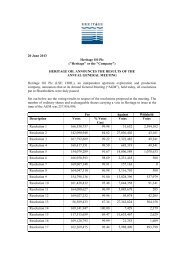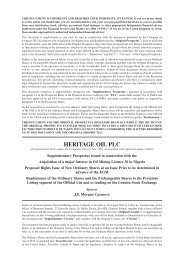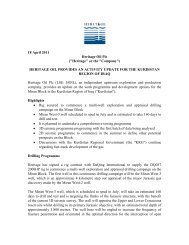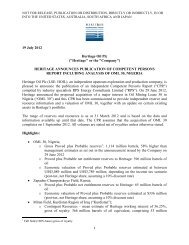Prospectus re Admission to the Official List - Heritage Oil
Prospectus re Admission to the Official List - Heritage Oil
Prospectus re Admission to the Official List - Heritage Oil
Create successful ePaper yourself
Turn your PDF publications into a flip-book with our unique Google optimized e-Paper software.
RPS Energy<strong>Heritage</strong> <strong>Oil</strong> – Competent Persons Reportco<strong>re</strong> and it is <strong>the</strong><strong>re</strong>fo<strong>re</strong> conside<strong>re</strong>d that <strong>the</strong> co<strong>re</strong> did not suffer filtrate invasion in <strong>the</strong> volumes sampled forwater extraction, and no invasion cor<strong>re</strong>ctions we<strong>re</strong> applied.Values of R w we<strong>re</strong> taken from <strong>the</strong> data supplied by <strong>Heritage</strong> whe<strong>re</strong> <strong>re</strong>sidual water was extracted from <strong>the</strong>co<strong>re</strong> and its <strong>re</strong>sistivity determined. The average value from 8 samples <strong>re</strong>ported was 0.277 Ohmm at 20 Cwith standard deviation of <strong>the</strong> mean of 0.012 Ohmm. Arps’ equation (8) was used <strong>to</strong> convert this <strong>to</strong> <strong>re</strong>servoirtemperatu<strong>re</strong>s. This <strong>re</strong>sistivity <strong>re</strong>p<strong>re</strong>sents an equivalent NaCl concentration of approximately 24,000 ppm.The <strong>re</strong>sult is in line with a p<strong>re</strong>viously <strong>re</strong>ported salinity from well No. 14 which gave a value of 22,105 ppm.The ambient Archie Cementation exponent ‘‘m’’ and Saturation exponent ‘‘n’’ derived from P3 co<strong>re</strong> we<strong>re</strong>1.77 and 1.85, <strong>re</strong>spectively. A produced water analysis was supplied by <strong>Heritage</strong> which was obtained bycentrifuging an oil sample from co-mingled production from Wells S226 and P3. The chemical analysisobtained a salinity of 49,454 ppm, which has an estimated R w of 0.143 Ohmm at 20 C.Because of <strong>the</strong> ambiguity in <strong>the</strong> <strong>re</strong>sults from <strong>the</strong> brine analyses, <strong>the</strong> 0.277 Ohmm R w at 20 C was used <strong>to</strong>calculate saturations at <strong>the</strong> p90 level, and <strong>the</strong> 0.143 Ohmm R w at 20 was used <strong>to</strong> calculate saturations at<strong>the</strong> p50 level.In <strong>the</strong> case of well P2ST, VSH was derived from <strong>the</strong> lower value from <strong>the</strong> density neutron cross plotmethod and a linear Gamma Ray VSH method derived from <strong>the</strong> Potassium and Thorium component of<strong>the</strong> gamma ray count. Parameters a<strong>re</strong> p<strong>re</strong>sented in Table 1 in <strong>the</strong> Appendix. For well P3, shale volume wasdetermined from a density neutron crossplot using <strong>the</strong> parameters p<strong>re</strong>sented in Table 2 in <strong>the</strong> Appendix.For well P2ST, porosity was derived using <strong>the</strong> density neutron crossplot method In <strong>the</strong> case of well P3,porosity was derived for <strong>the</strong> LCa and LCb zones using <strong>the</strong> density neutron crossplot method. Porosity inLCc was derived from <strong>the</strong> density log. The parameters used in calculating porosity for both wells a<strong>re</strong>p<strong>re</strong>sented in Tables 1 & 2 in <strong>the</strong> Appendix.For both wells, <strong>to</strong>tal water saturation was calculated using <strong>the</strong> Archie equation (9) . Effective watersaturation was derived using <strong>the</strong> shaley sand ‘‘Indonesia’’ Equation of Poupon and Leveaux (10) . A CPI(for <strong>the</strong> p50 saturation case) from Well P3 is shown in Figu<strong>re</strong> 15.Owing <strong>to</strong> <strong>the</strong> silty and thin bedded natu<strong>re</strong> of parts of <strong>the</strong> <strong>re</strong>servoir, it is possible that thin beds a<strong>re</strong> notbeing <strong>re</strong>solved fully by <strong>to</strong>ol <strong>re</strong>sponses, and that <strong>the</strong> <strong>re</strong>sults of <strong>the</strong> interp<strong>re</strong>tations have been influenced bysmoo<strong>the</strong>d <strong>to</strong>ol <strong>re</strong>sponses. A p50 case for water saturation has used an R w of 0.143 Ohm at 20 C. An R w of0.277 Ohm at 20 C has been used <strong>to</strong> construct saturations for <strong>the</strong> p90 case.(8) Arps, J.J. (1953) ‘‘The Effect of Temperatu<strong>re</strong> on <strong>the</strong> Density and Electrical Resistivity of Sodium Chloride Solutions’’Petroleum Transactions, AIME, Vol 198, 327-330.(9) Archie, G.E. ‘‘The Electrical Resistivity Log as an Aid in Determining Some Reservoir Characteristics’’. Petroleum Transactionsof <strong>the</strong> AIME 146 (1942).(10) A. Poupon, J, Leveaux ‘‘Evaluation of Water Saturation in Shaly Formations’’. SPWLA 12 th Annual Logging Symposium,May 2-5 1971.96















